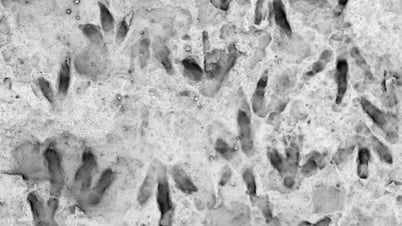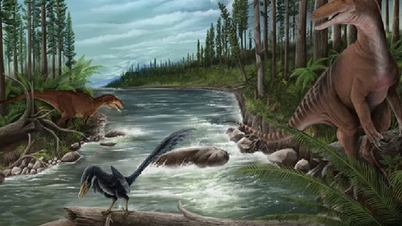(NLDO) - Egypt's Faiyum province not only has beautiful pyramids and oases, but also a terrifying beast that once dominated the post-dinosaur era.
According to Sci-News, an international research team has found the nearly complete skull of an extremely aggressive beast that quickly became the "king of the jungle" in the land that is now Egypt shortly after the dinosaurs became extinct.
It is the wolf-toothed hyena Bastetodon syrtos.

The skull of a wolf-toothed hyena is exposed in the sediments of the Oligocene period of the Paleogene period, which immediately followed the "golden" Cretaceous period of dinosaurs - Photo: AMERICAN UNIVERSITY IN CAIRO
The research team led by paleontologist Shorouq Al-Ashqar from Mansoura University and the American University in Cairo (Egypt) found the beast's skull in Oligocene sediment layers (about 33.9-23 million years ago) of the Palaeogen period.
“Wolf-toothed hyenas evolved long before modern carnivores such as cats, dogs and hyenas, and hunted in African ecosystems after the extinction of dinosaurs,” the authors said.
It is estimated that this animal weighed only about 27 kg when alive, with a body similar to a leopard today.
However, that body, combined with sharp teeth and strong jaw muscles, was enough to make it climb to the top of the food chain in the post-dinosaur ecosystem.
It had a "super-meat" diet, possibly hunting primates, early hippos, early elephants, and rock rats.
The beast's skull came to Dr. Al-Ashqar's research team by surprise.
Just as they were about to finish their work exploring the sedimentary layer in the Jebel Qatrani Formation, Faiyum Province - Egypt, a team member discovered a large set of teeth protruding from the rock.
The skull was then excavated and dated to be approximately 33.8 million years old.
Thus this terrible creature ruled ancient Egypt - then a verdant land - throughout the Oligocene and the millions of years that followed.
By 18 million years ago, some members of its lineage were still among the largest carnivorous mammals ever to have appeared on the planet.
“However, catastrophic global climate changes and tectonic shifts in Africa opened up the continent to relatives of modern cats, dogs, and hyenas,” the authors said.
It is unclear when or how the species became extinct, but the increasing presence of other fierce predators may have contributed to its disappearance. Now, the forest it once dominated has become desert.
Source: https://nld.com.vn/ke-soan-ngoi-khung-long-lo-dien-giua-lanh-dia-kim-tu-thap-196250219113013504.htm




![[Photo] Prime Minister Pham Minh Chinh chairs conference on anti-smuggling, trade fraud, and counterfeit goods](https://vphoto.vietnam.vn/thumb/1200x675/vietnam/resource/IMAGE/2025/5/14/6cd67667e99e4248b7d4f587fd21e37c)





























































































Comment (0)